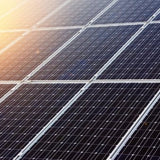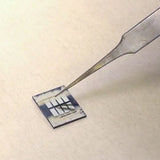OPV Polymers
Organic photovoltaic (OPV) polymer materials are a cutting-edge class of compounds designed to convert sunlight into electrical energy through the photovoltaic effect. These materials are composed of conjugated polymer systems, which either serve as electron donors or as electron acceptors in the photovoltaic process.
Key Features and Properties
- OPVs are distinguished by their flexibility, lightweight nature, and potential for low-cost production compared to traditional silicon-based solar cells.
- Their molecular structure allows for the fine-tuning of optical and electronic properties, such as the band gap, enabling them to absorb a broad spectrum of sunlight.
- The ease of processing these materials through printing technologies also stands out, offering a path towards scalable and environmentally friendly production of solar panels.
Our OPV semiconducting polymer donors and acceptors have a range of band gaps to suit your specific needs, so you can find the right materials for your organic solar cells. Maximize your device efficiency by fabricating and testing new devices in a glove box environment.
Jump to: Resources and Support
Browse OPV Polymers
Filter by type:
Page 1 of 2
Resources and Support
 Organic Solar Cells: An Introduction to Organic Photovoltaics
Organic Solar Cells: An Introduction to Organic Photovoltaics
Organic solar cells, also known as organic photovoltaics (OPVs), have become widely recognized for their many promising qualities. This page introduces the topic of OPVs, how they work and their development.
Read more... Organic Photovoltaics vs 3rd-Generation Solar Cell Technologies
Organic Photovoltaics vs 3rd-Generation Solar Cell Technologies
Whilst the majority of commercial solar cells are currently made using crystalline silicon (c-Si), thin-film alternatives have the potential to be cheaper, flexible, and more straightforward to produce. These technologies can be classified as second-generation cells (e.g. cadmium telluride (CdTe)), or third-generation (e.g. perovskite solar cells).
Read more... Solar Cells: A Guide to Theory and Measurement
Solar Cells: A Guide to Theory and Measurement
A solar cell is a device that converts light into electricity via the ‘photovoltaic effect’. They are also commonly called ‘photovoltaic cells’ after this phenomenon, and also to differentiate them from solar thermal devices. The photovoltaic effect is a process that occurs in some semiconducting materials, such as silicon.
Read more...While a large part of research into the bulk heterojunction morphology of organic solar cells focuses on component choice,1 the morphology is also tuned by a host of processing conditions. Recently, Singh et al.2 published work into optimising three of these conditions; the molar mass ratio of the donor:acceptor blend, the annealing temperature of the active layer and the cathode buffer layer choice.
Read more... Factors Influencing OPV Stability
Factors Influencing OPV Stability
Typically, organic photovoltaics (OPVs) are manufactured in the form of a bulk heterojunction (BHJ) cell, where the active layer consists of a blend of donor and acceptor materials with various interfacial layers and electrodes (seen in Figure 1). For OPVs to be commercially competitive with existing solar technologies, a ’10/10’ target must be reached, which refers to a 10% power conversion efficiency (PCE) and 10-year lifetime.
Read more... Understanding HOMO and LUMO
Understanding HOMO and LUMO
HOMO (Highest Occupied Molecular Orbital) and LUMO (Lowest Unoccupied Molecular Orbital) are fundamental concepts in molecular orbital theory. HOMO and LUMO are known as the "frontier molecular orbitals" because they are the highest occupied and lowest unoccupied molecular orbitals, respectively.
Read more... Polymer-Fullerene Bulk Heterojunction Solar Cells: Theory, Requirements and Device Engineering
Polymer-Fullerene Bulk Heterojunction Solar Cells: Theory, Requirements and Device Engineering
Polymer-fullerene bulk heterojunction (BHJ) solar cells are based on blends of semiconducting polymers and fullerene derivatives, such as PCBM. It is described as a bulk heterojunction as it involves a blend of two materials with differing energy band gaps, forming a dispersed, interpenetrating network.
Read more... Organic Solar Cell Fabrication Guide
Organic Solar Cell Fabrication Guide
This guide demonstrates how to fabricate standard organic solar cells (OSCs) using materials and equipment that are readily available. Find out more.
Read more...






































